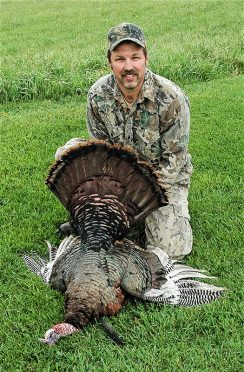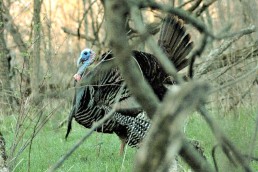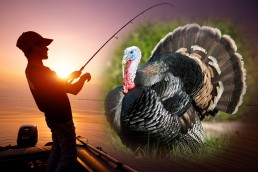Considerations in Preparing for your Spring Turkey Hunt
SHARE THIS POST
Whenever failure destroys objective, it’s usually because of lack of preparation. When hunting spring gobblers, there are preparation efforts hunters should consider for optimum results. Therefore, each hunter should prepare for spring turkey hunting in many ways.
As wild turkey activities transition into breeding intentions, if there’s one downfall that overthrows spring turkey hunters, it’s not preparing properly.
Four tips to take down toms
- Carefully determine hunting habitats through extensive scouting
- Rehearse (practice) shotgun or bow use
- Select flawless camo patterns
- Practice with your calls
Pick the spot
Set the stage now by getting focused and verifying hunting terrains. If you hunt public acreage, the Division of Wildlife can provide prior year’s statistics confirming per-county harvest figures where the most gobblers have been tagged. Select several locations so you can change hunting spots if you encounter other hunters or gobbler responses become sporadic. If you hunt private lands, secure permission and scout thoroughly. Your efforts will prepare you before turkeys are triggered into their breeding frenzy. Undoubtedly, self-preservation helps wild turkeys survive. Make your plans and pick your spot to take out a tom.
Hunt areas for 2019
Hunter’s must be aware there are two hunting zones for 2019. The Northeast Zone covers Ashtabula, Cuyahoga, Geauga, Lake and Trumbull Counties. Ohio’s South Zone covers the remainder of the state.
NE Ohio Spring Turkey opens April 29. Hunting hours are 30 minutes before daylight until noon. Then, this zone closes May 26.
The South Zone encompasses the rest of Ohio. Legal season opens April 22rd, 30 minutes before daylight until noon. Closing date is May 19th, 2019. Regardless of the counties you hunt, always confirm dates, times and check-in times with your Hunting Regulation Brochure. Or, contact the Ohio Division of Wildlife’s website at wildohio.gov.
Get ready
Prepared hunters begin with physical conditioning. Winter can weaken our bodies, especially if our lifestyle isn’t physically demanding. Develop a routine of long walks, sit-ups, pushups and jogging. Strength and endurance will help keep you alert. Develop your checklist now. Confirm places to hunt, whether private, or public lands. Gain permission from private landowners. Assemble all your gear. Scout as frequently as possible because turkeys often change locations.
Always confirm any landowner’s permission each year. Even if you’ve hunted a location previously, it’s still essential to review the landscape again. It’s also vital to be aware of your surroundings and the possible presence of other hunters while hunting, especially those who might trespass. You don’t want to become a gunshot victim, nor do you want other hunters stepping into your sights. Safety is always imperative!
Are you enjoying this post?
You can be among the first to get the latest info on where to go, what to use and how to use it!
Know your prey
 Successful turkey hunting is always improved by knowing where birds are located. This is accomplished through early scouting. You won’t tag mature gobblers if you can’t find them. You can’t find them if you don’t understand their habits, roosting sites, feeding areas and strutting niches.
Successful turkey hunting is always improved by knowing where birds are located. This is accomplished through early scouting. You won’t tag mature gobblers if you can’t find them. You can’t find them if you don’t understand their habits, roosting sites, feeding areas and strutting niches.
Turkeys will winter in different locations from spring. If you’ve hunted a place previously, however, you’ll have a better idea where birds hang out. At least, that is, if habitat features haven’t been altered.
Save time and footwork by studying topographic maps at home to learn landscape details. You will determine the location of hiking trails, logging roads, power lines and gas-line corridors, as well as open fields and dense woodlands. Topographical maps give hunters an intimate view of landscape features before they set foot in an area. Google’s aerial map view also aids your scouting. Now’s also the time to carry binoculars so you can scan open landscapes for birds without disturbing their activities.
Practice your call
How much expertise one needs with calling devices is often debated. However, understanding what calling sounds to use at any given point during each hunt is an important component. Turkey calling practice should begin weeks before legal season. In fact, practice is advisable year-round.
Turkey vocals aren’t sounds that can easily be explained on paper and be understood. In order to grasp the tonal definition of turkey language, it helps to be afield and listen to wild birds calling. You will be able to audibly decode their calls more accurately. Familiarize yourself with their rhythmic vocals and at what point during any hunt to apply these sounds. Learn to use several types of calls so you can produce many different vocals, as well.
Practice your shot
As you prepare for spring gobblers, reacquaint yourself with judging yardage. Many hunters fail to comprehend the actual body size of a wild bird. Why not try a quick reference tool. Place lifelike decoys at 10, 20, 30 and 40 yards, and compare their sizes. This visual trick helps familiarize you with a bird’s body size. Judging distance by body size is important for a fatal shot. You must also be confident with your shotgun or bow. Practice, even if you feel certain of your abilities. It’s crucial to pattern your shotgun to confirm a tight pattern. Also, practice shooting right and left-handed. It will give you an edge if a gobbler circles you. Don’t spare the cost of shotgun shells or new broadheads. Be absolutely certain of your gun or bow’s performance well before you hunt.
Dress for success
Think you’re camouflaged? Does your camo fit? Is it faded? Do you have suitable gloves and head nets? Is your footwear adequate? Are you prepared for changing weather conditions? Improve your concealment attire by studying yourself dressed in full camo in front of a full-length mirror. Are you comfortable with your appearance? Is the pattern appropriate for the habitat you intend to hunt? For example: Don’t use a hardwoods pattern in a pine grove. Equally important, be certain your shotgun or bow is perfectly camouflaged.
Try on your boots. If they’re new, wear them frequently so they mold with your feet. In addition, lay-out all your equipment weeks before season. Each call should have a specific place in your vest or jacket pockets so you can grab any call within seconds, without thinking. Practice everything you normally do when hunting weeks before April’s gobbler season opens.
MWO
SHARE THIS POST
Did you enjoy this post?
You can be among the first to get the latest info on where to go, what to use and how to use it!
Bob Grewell
Bob “Greenie” Grewell has written about and photographed the outdoors for 40 years. He’s travelled throughout the U.S., Canada, the Arctic Circle, as well as Germany and Denmark. He has written a book on hunting dogs and contributed articles and photography to others. He currently focuses on deer and turkey articles, and wildlife photography.



